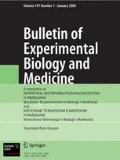The effects of nootropic drug Semax on the neuronal network of the brain were studied by the resting state functional magnetic-resonance imaging (resting state fMRI). The study was carried out on two groups of healthy volunteers (11 men and 13 women aged 43.9±9.5 years). Resting state fMRI was carried out 3 times: directly before and 5 and 20 min after intranasal 1% Semax (14 subjects) or placebo (10 subjects). The topography of the resting state default mode network was studied. A greater volume of the default mode network rostral (medial frontal cortex) subcomponent was detected in the Semax group in comparison with controls. Resting state fMRI confirmed Semax effects on the neuronal network of the brain and demonstrated topography of these effects.
Similar content being viewed by others
References
Luria AR. Basics of Neuropsychology. Moscow, 2003. Russian.
The Use of Peptide Neuroprotector Semax 1% during the First Hours and Days of Cerebral Stroke. Skvortsova VI, ed. Moscow, 2011. Russian.
Cao W, Cao X, Hou C, Li T, Cheng Y, Jiang L, Luo C, Li C, Yao D. Effects of cognitive training on resting-state functional connectivity of default mode, salience, and central executive networks. Front. Aging Neurosci. 2016;8:70. doi: https://doi.org/10.3389/fnagi.2016.00070.
Greicius MD, Menon V. Default-mode activity during a passive sensory task: uncoupled from deactivation but impacting activation. J. Cogn. Neurosci. 2004;16(9):1484-1492.
Li W, Mai X, Liu C. The default mode network and social understanding of others: what do brain connectivity studies tell us. Front. Hum. Neurosci. 2014;8:74. doi: https://doi.org/10.3389/fnhum.2014.00074.
Mazoyer B, Zago L, Mellet E, Bricogne S, Etard O, Houdé O, Crivello F, Joliot M, Petit L, Tzourio-Mazoyer N. Cortical networks for working memory and executive functions sustain the conscious resting state in man. Brain Res. Bull. 2001;54(3):287-298.
Patel R, Spreng RN, Turner GR. Functional brain changes following cognitive and motor skills training: a quantitative metaanalysis. Neurorehabil. Neural Repair. 2013;27(3):187-199.
Raichle ME, MacLeod AM, Snyder AZ, Powers WJ, Gusnard DA, Shulman GL. A default mode of brain function. Proc. Natl Acad. Sci. USA. 2001;98(2):676-682.
Reineberg AE, Andrews-Hanna JR, Depue BE, Friedman NP, Banich MT. Resting-state networks predict individual differences in common and specific aspects of executive function. Neuroimage. 2015;104:69-78.
Shadrina M, Kolomin T, Agapova T, Agniullin Y, Shram S, Slominsky P, Lymborska S, Myasoedov N. Comparison of the temporary dynamics of NGF and BDNF gene expression in rat hippocampus, frontal cortex, and retina under Semax action. J. Mol. Neurosci. 2010;41(1):30-35.
Shirer WR, Ryali S, Rykhlevskaia E, Menon V, Greicius MD. Decoding subject-driven cognitive states with whole-brain connectivity patterns. Cereb. Cortex. 2012;22(1):158-165.
Tsai SJ. Semax, an analogue of adrenocorticotropin (4-10), is a potential agent for the treatment of attention-deficit hyperactivity disorder and Rett syndrome. Med. Hypotheses. 2007;68(5):1144-1146.
Author information
Authors and Affiliations
Corresponding author
Additional information
Translated from Byulleten’ Eksperimental’noi Biologii i Meditsiny, Vol. 165, No. 5, pp. 597-600, May, 2018
Rights and permissions
About this article
Cite this article
Lebedeva, I.S., Panikratova, Y.R., Sokolov, O.Y. et al. Effects of Semax on the Default Mode Network of the Brain. Bull Exp Biol Med 165, 653–656 (2018). https://doi.org/10.1007/s10517-018-4234-3
Received:
Published:
Issue Date:
DOI: https://doi.org/10.1007/s10517-018-4234-3




